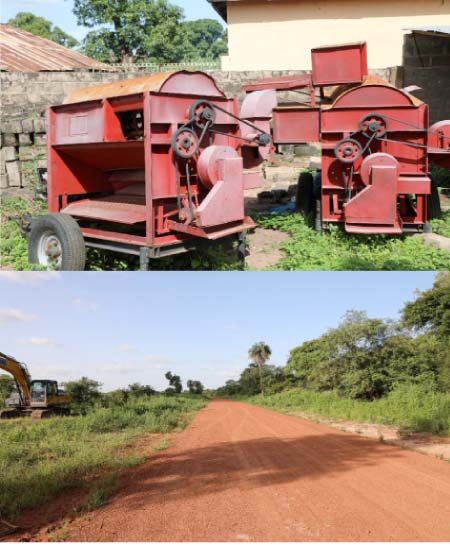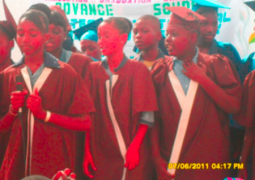
(Wednesday 23rd October 2019 Issue)
In
Central River Region North, a 6.5 kilomtre access road from Lamin Koto-Kuntaur
Highway has already been constructed by the Ministry of Agriculture. It leads
to Kuntaur Fulla Kunda, Touba Kuta, Touba Koto and Sukuta villages – all
farming communities in Niani district. With rice threshers, milling machines,
Turu Yiriwandi Kafoo (a seeds cultivation group) and Fandema Kafoo (a self-help
group) managed to purchase a tractor worth D2 million. Their goal: to feed the
Gambian population through sale of their surplus produce countrywide.
It is ambitious but not unachievable.
Currently, The Niani Sukuta groups are mobilizing 2,200 50kg-bags of seeds in
their community store. Their biggest customer is the World Food Programme that
purchases rice from them to supply to schools in the Central River Region as
part of the School Feeding programme. This programme has changed its focus of
importing food stuffs into the country to feed school children in The Gambia.
WFP had signed an agreement with government and producers to purchase locally
grown foodstuffs from farmers and supply the schools. This supports the
government’s food security policy.
The
Food and Agricultural Organisation had supplied a heavy duty processing machine
to Fandema Kafo about five years ago. Unfortunately, the machine has not begun
functioning because the farmers have not been able to produce the one-tonne
minimum requirement for it to begin full swing. Despite the vast land
available, the over 200 member group can only boost production capacity through
the use of technology. Lessons could be learned from industrialised countries
and how machines about a Century ago outwitted human production capacity. This
spurred the agricultural revolution in the United States and the industrial
revolution in Europe.
An Agriculture Master Plan
Meanwhile
in The Gambia, the smallholder farmers that comprises over 70 percent of the
farming population of The Gambia’s farmers still rely mainly on ox and
donkey-driven machines for subsistence farming. Mechanisation has been a
distant dream. According to the FAO, low private investment, especially in the
value added sector, has resulted in the stagnation and or declining performance
in production.
The challenge of the current government is the
impact of the declining international agricultural commodity prices; soaring
prices of food commodities and essential production inputs, inadequate domestic
policies, institutional support and investment in the sector, particularly
roads and equipment. These challenges
dictate that government formulates an Agriculture Master Plan in the context of
the National development Plan 2018-2021.
Hence to achieve long-term food security as
well as reducing poverty levels, the government of President Adama Barrow
considers agriculture as central to country’s economic advancement, and an
improved health of the population through nutrition security.
Agriculture provides employment for 70 per
cent of the population, exports and foreign exchange earnings for the economy
and food security for the citizens. In the NDP, the infrastructure projects
such as road networks, the tourism masterplan and other sectoral strategies
being implemented by the government will become key. It has a task to rebuild
an agricultural system that had been downtrodden by two decades of political
interference, misuse of donor funds and failed policies.
Creating employment for the youth
In
URR, a recently constructed 3.5 km access road, like dozens of other roads
across rural Gambia has now made it possible for farmers, especially women, to
access rice fields without hindrance. These access roads also enable producers
to access markets for their produce; transporters would face less hurdles and
transportation charges are less costly for farmers.
“We used to trek this road, half-submerged in
water while carrying loads on our heads and babies on our backs. Today, we
walk… we ride carts and bicycles or motorbikes smoothly to the fields,” said Yoba
Baldeh in Kossemar village, where a pilot 50-hectare irrigation project is at
advanced stage of completion.
Kossemar benefitted from a tractor, three
power tillers, three threshers and a rice planter to help boost their
productions. “This will create employment for the youths of the village,” said
Musa Jawo, the VDC Chairman of this 54-compound,1,800 population village.
“It will be a great improvement on our lives
once the work starts. We have invited other surrounding villagers to
participate in the cultivation of rice here. So far, we are growing millet,
coos, ground nuts, rice and we engage in horticulture,” Jawo added.
Food importation
President
Barrow’s preoccupation since coming to office is to cut the country’s reliance
on imported rice, link local production to national markets, as well as a
strong value addition industry. The reality is that The Gambia relies mostly on
imported rice for consumption, while producing only 15 per cent of its
consumption needed annually.
At Sapu, which that is the nerve centre of the
CRR agricultural production, the Chinese Technical Team that arrived in
September 2019 had already established both their office and residence. It is
expected to inject a fresh production capacity into Jahally-Pacharr fields, and
others in Niamina and beyond. The project is the first agriculture cooperation
project after the People’s Republic of China established diplomatic relations
with The Gambia. LONGPING High-Tech is the implementation unit of the project.
China and The Gambia once had a good
cooperation in agriculture as early as 44 years ago under the PPP regime. The
Chinese government had sent experts to The Gambia to help farmers increase
their productivity. The local people until today, fondly call many lands as
‘Chinese rice fields’ – out of the knowledge that wherever the Chinese experts
worked, there were abundant of food.
Hybrid rice, agricultural demonstration and
training are the main content of the project in Sapu. It would establish 5
hectares of hybrid rice, 2 hectares vegetable demonstration and guide 1,000
hectares of demonstration area. The loss rate of post-product processing in
demonstration area will decrease by half, from 40% to 20%. The project will
select 2-3 high-yielding rice and vegetable varieties appropriate for the local
environment.
It will organize the technical training for
Gambian personnel both in China and The Gambia. The total number of trainees
targeted is about 1,500 personnel. Already, the project had organized the
training lessons for the students in Gambia College and local farmers. It is
hoped that the project will contribute to the Gambia’s high grain yield and
bring the Chinese agriculture technology and knowledge transfer to The Gambia.
Rainfall patterns
Rainfall
patterns in The Gambia for the past years or more have been shifting, to the
annual dismay of rural farmers. They mostly lose the first of their early crops
to weeks of drought after sowing. This year, a similar phenomenon affects
thousands across board who traditionally begin sowing between June and July.
Most of the rains lost in early months of the
season are currently being delivered at the tail end of the season. Fields in
the lowlands are mostly flooded. Those who replanted after early droughts are
glaring hope in the season’s harvests. Millets, groundnuts, coos, corn and rice
will turn out for the better this year.
The prospects for this year’s harvests remain
high despite earlier doubts of drought between July and August this year.


